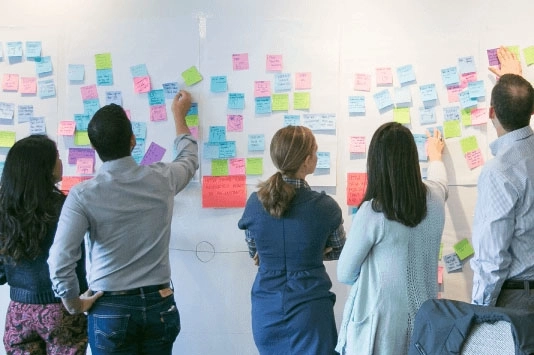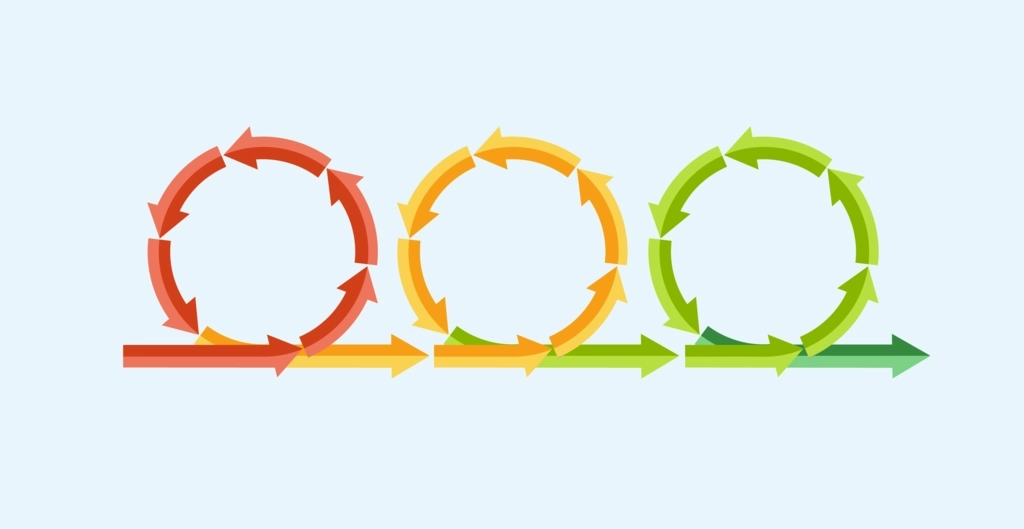
How to write user stories in product development with examples

A user story is a short, simple description of a feature told from the perspective of the person who desires the new capability, usually a user or customer of the system. It outlines what they need, why they need it, and the benefits. It follows the format: "As a [role], I need [feature] so that [benefit]." User stories help ensure the development work focuses on the user's needs and provides clear criteria for what needs to be done to satisfy those needs.
Since user stories are a way to define the user’s needs, the goal is to provide user-focused solutions. This is why the UX team is often involved with creating user stories. However, user stories are the responsibility of all team members and should be easily understood by everyone.
What are user stories?

User stories are informal ways to describe a system's features, written from the perspective of the end user. By creating user stories, it is easier to create user-centered designs since you are in the user's mindset.
It’s important to understand the users who you’re designing for. In many cases, personas play a key role in the process of writing user stories.
Personas help you understand your users’ needs, experiences, behaviors, and goals, which can help you plan and define your features.
Knowing who the product users are, what they want to achieve, and the common user scenarios will create a streamlined approach to the process of writing user stories. This will help build empathy with your users. Any UX research and testing programs will be able to provide solutions for creating a seamless user experience.
Successful projects require collaboration and a shared vision of the end-user. Therefore user stories can help build a common goal and vision so that stakeholders and team members can remain focused on the user and what the project is trying to achieve.
Examples of user stories in UX
- As a frequent shopper, I need a way to easily repeat past orders to save time on grocery shopping.
- As a new user, I need to be able to quickly sign up with my social media account so that I can skip long registration processes.
- As a content creator, I need to receive notifications about comments on my posts so that I can engage with my audience promptly.
Why are user stories essential in UX design?
Here are a few key benefits of user stories:
- Successful team collaboration. When you summarize user goals in a way that is easy to understand, everyone is on the same page.
- Create a concrete view of the user. User stories give the project team what they need to create a concrete view of the user. They’re a great reference for the development team and a way to document why certain features are being developed.
- Prevent "feature creep." This is something that happens frequently to UX/UI designers – adding more features and expanding the project requirements beyond the initial scope.
- Create successful digital products. The primary focus when writing user stories is the user’s needs and what they want to accomplish.
How to create an effective user story

Creating effective user stories is a critical step in agile software development, guiding teams to deliver value to users efficiently. Here’s a step-by-step guide to crafting user stories that resonate with needs, streamline development, and ensure your product development efforts are user-focused.
1. Identify the user
Start by identifying who the user is. This step involves understanding the various user personas that interact with your product. A user persona is a semi-fictional character that represents a significant user segment. By clearly defining the user persona, you're ensuring that the user story is focused and relevant. Consider demographics, motivations, and the user's goals when creating personas. This specificity helps in making the user story not just a task but a narrative that everyone on the team can understand and empathize with.
2. Define what the user wants to accomplish
The next step is to articulate what the user wants to accomplish. This is the action or the task that the user needs to perform with the help of your product or service. It’s crucial to be clear and specific; instead of saying "the user wants to manage tasks," say "the user wants to categorize tasks by priority to focus on urgent matters first." This specificity helps in creating a user story that is actionable and directly tied to the user's needs.
3. Clarify why the user wants to accomplish this
Understanding why the user wants to accomplish a task adds depth to the user story. This "why" often relates to the benefits or value the user gains by completing the task. It could be to save time, reduce errors, or enhance productivity, for example. By adding this layer, you’re aligning the user story with user needs and business objectives, making it a powerful tool for prioritization and decision-making.
4. Write the user story
Now, combine the first three steps into the user story format: As a [user type], I want to [task] so that [reason]. This format keeps the user story concise and focused, making it easy for the team to understand and act upon. Remember to use active voice and ensure the story is clear and straightforward, avoiding technical jargon that might alienate non-technical team members.
5. Refine and prioritize
After writing the user story, review it with stakeholders and the development team to refine and ensure it meets the user's and business's needs. This collaborative approach may lead to revisions for clarity, feasibility, and alignment with project goals. Once refined, prioritize the user story within the product backlog. Prioritization should be based on the story's value to the user and the business and its complexity and dependencies.
6. Acceptance criteria
Define acceptance criteria that specify the conditions under which the user story is considered complete. These criteria should be clear, measurable, and testable, providing a checklist that guides development and quality assurance. The acceptance criteria ensure that the solution meets the user's needs as defined in the user story and supports a shared understanding of what success looks like.
7. Continuous review and adaptation
User stories are not set in stone. As development progresses and more is learned about the user's needs and the technical landscape, user stories may need to be updated, split into smaller stories, or even discarded if they no longer align with the project's direction. This iterative process ensures that the team remains focused on delivering value to the user throughout the project lifecycle.
By following these steps, you can craft effective user stories that guide your development efforts, ensuring that the final product meets the real needs of your users.
Role of user stories in Agile development

User stories are not requirements." - Dean Leffingwell Cofounder and Board Member at Scaled Agile, Inc.
User stories play a pivotal role in Agile development methodologies, serving as the fundamental building blocks that guide the creation and refinement of features within an Agile framework. Their integration into Agile practices emphasizes the user-centric approach to product development, ensuring that the end product delivers real value to its users.
Incorporating SAFe Lean Agile principles helps teams align user stories with customer needs and organizational goals, providing a structured approach to scaling Agile practices across enterprises. These principles focus on optimizing the flow of value through continuous delivery and Lean Thinking. SAFe's Lean Thinking principles emphasize minimizing waste and maximizing value, which is essential when crafting concise and impactful user stories. The pillars of SAFe, including alignment, built-in quality, transparency, and program execution, serve as a guide when defining user stories to ensure they meet enterprise-level quality and alignment. Here’s how user stories enrich the Agile development process:
Fostering collaboration and communication
User stories act as a common language between the development team, stakeholders, and users. They help break down barriers of technical jargon, making the project's goals and requirements accessible and understandable to all parties involved. The primary goal of SAFe is to scale Agile practices across large enterprises, ensuring that user stories contribute to the broader organizational objectives. This inclusivity enhances collaboration and ensures that everyone is aligned on what the product should achieve, why it matters, and for whom it is being developed. Agile teams often discuss user stories in planning meetings, retrospectives, and daily stand-ups, reinforcing a continuous dialogue about user needs and product direction.
Guiding iterative development

Agile development is characterized by iterative cycles, where the product is developed, tested, and improved in short sprints. User stories are integral to this process, providing a clear, concise description of what needs to be built in each iteration. They allow teams to focus on delivering small increments of value quickly and efficiently, with each user story representing a specific piece of functionality that can be developed, tested, and potentially released in a single sprint. This approach enables rapid feedback and adjustments, ensuring the product evolves in a direction that meets user expectations.
Prioritizing work based on user value
In Agile methodologies, work is prioritized based on the value it delivers to the user. SAFe Principle #10 emphasizes the importance of organizing around value, which directly influences how user stories are prioritized and implemented. User stories facilitate this by clearly outlining the benefits of each feature from the user's perspective. This helps teams make informed decisions about what to work on next, ensuring that the most critical and valuable features are developed first. Prioritization based on user stories also ensures that resources are allocated efficiently, focusing on work that directly contributes to achieving the product's goals and satisfying user needs.
Enhancing flexibility and adaptability
Agile development values adaptability, and user stories support this by being open to change. The focus of Lean Thinking in SAFe is to streamline processes and deliver value efficiently, which should be reflected in how user stories are formulated and executed. As teams learn more about the user's needs, market conditions, or technological advancements, user stories can be updated, reprioritized, or even discarded to reflect new insights. This flexibility allows Agile teams to remain responsive to change, ensuring that the product development process is always aligned with the most current understanding of what users want and need.
Streamlining feedback and validation
User stories are designed to be testable, with clear acceptance criteria that define success for each story. This structure supports continuous testing and validation throughout the development process. By meeting the acceptance criteria, the team can confidently say that they have addressed the user's needs as defined in the user story. This ongoing validation process ensures that the product works as intended and delivers the intended value to users, reducing the risk of developing features that miss the mark.
Integrating user stories into Agile development methodologies underscores a commitment to user-centered design and development. SAFe extends the principles of the Agile Manifesto, ensuring that even in large-scale projects, user stories remain user-centric and value-driven. By articulating users' needs and values in a straightforward and actionable format, user stories ensure that Agile teams always work towards the most impactful and meaningful outcomes. They facilitate collaboration, guide iterative development, prioritize work based on user value, enhance flexibility, and streamline feedback and validation, making them indispensable tools in the Agile toolkit.
Common challenges in user story implementation
Implementing user stories in Agile development can encounter several challenges. Recognizing these obstacles and applying effective strategies can greatly enhance the process, ensuring that user stories contribute positively to the development cycle. Below, we delve into common challenges and propose solutions to overcome them.
Dealing with ambiguous requirements
Challenge: One of the main challenges in implementing user stories arises from ambiguous or unclear requirements. Ambiguity can lead to confusion, misinterpretation, and wasted effort as developers may not have a clear understanding of what needs to be built.
Solution: To combat ambiguity, ensure that user stories are well-defined and specific, with clear acceptance criteria. Involve users or stakeholders in the creation process to gain a better understanding of their needs and expectations. Regular review sessions with the team can also help clarify any uncertainties before development begins. Utilizing techniques such as user story mapping can further enhance clarity by visually laying out the user’s journey and the role of each story within it.
Handling changes in user stories during development
Challenge: Agile development is dynamic, and changes during the development process are common. However, frequent changes to user stories can disrupt the workflow, causing delays and potentially impacting the project timeline and budget.
Solution: While agility and flexibility are key, it's important to manage changes with a structured approach. Implement a change control process that evaluates the impact of any alteration to a user story. Engage the team in discussions about the change to understand its implications fully. Emphasize continuous communication with stakeholders to ensure that changes are aligned with overall project goals and user needs. Prioritizing changes based on their value and impact helps maintain focus and momentum.
Addressing conflicts and miscommunication
Challenge: Conflicts and miscommunication can arise from differing interpretations of user stories or disagreements on priorities. Such issues can hinder progress and negatively affect team dynamics and product quality.
Solution: Foster an environment of open communication and collaboration within the team and with stakeholders. Encourage regular stand-ups, retrospectives, and planning meetings where concerns can be openly discussed and resolved. Utilize visual aids and examples to clarify user stories and ensure a shared understanding. Establishing a clear prioritization framework can also help resolve conflicts about what to work on first. When conflicts arise, focus on finding solutions that align with the user’s best interest and the project’s objectives.
Implementing these solutions can significantly mitigate the challenges associated with user story implementation in Agile development. By focusing on clarity, communication, and flexibility, teams can navigate these challenges effectively, ensuring that user stories drive the development process toward successful outcomes.
Acceptance criteria

Once you’ve written a few of these, it becomes apparent that the overall structure of a user story is quite simple. A user story describes the work that needs to be done. How do you know that this work has been done and that the user story is complete? This is where acceptance criteria comes in.
Things can get very complex based upon the type of functionality you’re describing in the story. There needs to be some criteria defined that go along with the user story, which is referred to as the acceptance criteria. Each user story has its own acceptance criteria.
The user story is the most important piece since it describes the high-level goal. Acceptance criteria is typically in list form and each item is tested against them, one by one. When each acceptance criteria item has been fully tested and passed, the user story is complete.
Here’s a simple example:
User story: As a credit card holder, I need to view my rewards points, so that I can get cash back.
Acceptance criteria:
- Show my reward point balance after I log into my account
- Display total available reward point balance
- Show the date when the total was last updated
- Show an error message if the reward point balance cannot be displayed. “Sorry, your rewards balance cannot be displayed. The issue is temporary, so please try again soon.”
Hierarchy of user stories
The goal of using stories isn’t to write better stories. The goal of product development isn’t to make products.”― Jeff Patton, User Story Mapping: Discover the Whole Story, Build the Right Product
Hierarchy is important to keep in mind. User stories are typically small and often groups of user stories, known as epics, are required for larger product features.
Epics are used as a high-level overview of the needed features, and are named according to a set of common user stories. The number of user stories can vary, but in many cases there can be quite a few.
For example: Let’s say we’re creating a video game and have an epic for "Create my avatar." It seems simple enough, but many user stories would be needed to make this a reality. This epic would contain the documented work that can be broken down into a number of user stories.
Summary
Keeping in mind the user type, what they want to accomplish, and why they want to accomplish the task, user stories provide the team with clarity on the project and what they should build.
Writing clear and concise user stories, ensures an efficient way to communicate and summarize the work that needs to be done.

Watch a demo
See how easy it is to get fast feedback on a website, prototype, design, or more in this demo.





